I have a GLKView which pretty much displays the shape I want but there are a few things that still do not work as desired.
3_______________________2
|\ /|
| \_ _ _ _ _ _ _ _ _ _/ |
| /4 5\ |
|/_____________________\|
0 1
texture mapping is working on the front-face, the other two faces do not really work, there are triangles lacking.
When I use colours, the faces seem to appear as desired, however the back faces do not join at the edge formed by the points 4 and 5 (look at the drawing I provided above).
I want (if you look at it from the side) the three faces to shape an equilateral triangle.
I have temporarily commented out the texture mapping sections of the code so that you can test it If you like.
Here I set up my view (note my view's dimensions. The coordinate system works fine without fiddling around with low values. The faces look good, they just do not, as I said join at the back):
EAGLContext * context = [[EAGLContext alloc] initWithAPI:kEAGLRenderingAPIOpenGLES2];
OpenGLShape *view = [[OpenGLShape alloc] initWithFrame:CGRectMake(0, 200, 320, 80) context:context];
view.delegate = view;
[view setupGL];
[self.view addSubview:view];
- (void)setupGL {
[EAGLContext setCurrentContext:self.myContext];
//glEnable(GL_CULL_FACE);
self.effect = [[GLKBaseEffect alloc] init];
BOOL useTexture = NO;
// Create default framebuffer object.
glGenFramebuffers(1, &defaultFrameBuffer);
glBindFramebuffer(GL_FRAMEBUFFER, defaultFrameBuffer);
if(useTexture){
NSDictionary * options = [NSDictionary dictionaryWithObjectsAndKeys:
[NSNumber numberWithBool:YES],
GLKTextureLoaderOriginBottomLeft,
nil];
NSError * error;
NSString *path = [[NSBundle mainBundle] pathForResource:@"blogcell@2x" ofType:@"png"];
GLKTextureInfo * info = [GLKTextureLoader textureWithContentsOfFile:path options:options error:&error];
if (info == nil) {
NSLog(@"Error loading file: %@", [error localizedDescription]);
}
self.effect.texture2d0.name = info.name;
self.effect.texture2d0.enabled = true;
glGenBuffers(1, &texArray);
glBindBuffer(GL_ARRAY_BUFFER, texArray);
glEnableVertexAttribArray(GLKVertexAttribTexCoord0);
glVertexAttribPointer(GLKVertexAttribTexCoord0, 2, GL_FLOAT, GL_FALSE, 0,0);
glBufferData(GL_ARRAY_BUFFER, sizeof(TexCoords), TexCoords, GL_STATIC_DRAW);
}else{
glGenBuffers(1, &colArray);
glBindBuffer(GL_ARRAY_BUFFER, colArray);
glEnableVertexAttribArray(GLKVertexAttribColor);
glVertexAttribPointer(GLKVertexAttribColor, 4, GL_FLOAT, GL_FALSE, 0, 0);
glBufferData(GL_ARRAY_BUFFER, sizeof(Color), Color, GL_STATIC_DRAW);
}
glGenRenderbuffers(1, &depthBuffer);
glBindRenderbuffer(GL_RENDERBUFFER, depthBuffer);
glRenderbufferStorage(GL_RENDERBUFFER, GL_DEPTH_COMPONENT16, 320.0f, 80.0f);
glFramebufferRenderbuffer(GL_FRAMEBUFFER, GL_DEPTH_ATTACHMENT, GL_RENDERBUFFER, depthBuffer);
glEnable(GL_DEPTH_TEST);
glGenBuffers(1, &vertexArray);
glBindBuffer(GL_ARRAY_BUFFER, vertexArray);
glEnableVertexAttribArray(GLKVertexAttribPosition);
glVertexAttribPointer(GLKVertexAttribPosition,3,GL_FLOAT,GL_FALSE,0,0);
glBufferData(GL_ARRAY_BUFFER, sizeof(Vertices), Vertices, GL_STATIC_DRAW);
self.effect.transform.projectionMatrix = GLKMatrix4MakePerspective(51.4f,4.0f, 0.1f, 10.75f);
rotMatrix = GLKMatrix4Translate(self.effect.transform.modelviewMatrix,0, 0, -3);
}
- (void)glkView:(GLKView *)view drawInRect:(CGRect)rect {
self.opaque = NO;
glClearColor(0.0f, 0.0f, 0.0f, 0.0f);
glClear(GL_COLOR_BUFFER_BIT | GL_DEPTH_BUFFER_BIT);
[self.effect prepareToDraw];
glDrawArrays(GL_TRIANGLES, 0, sizeof(Vertices));
}
red = front face (made up by points 0123)
blue = back face (top - made up by points 4523)
green = back face (bottom - made up by points 0154)
white = background
I have also made the faces semi-transparent (alpha = 0.5) for the sake of seeing whether they blend/cull etc.
